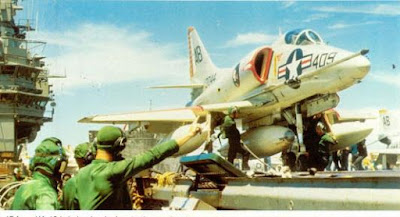The Douglas A-4 Skyhawk was a carrier-borne attack aircraft used by the US Navy and Marine Corps during the Cold War. Technically, it was a light bomber. However, it had the maneuverability of a fighter. It was also accurate in the ground-attack role, since it had excellent handling qualities flying at low levels. It showed these flight virtues during the Vietnam War, operating from aircraft carriers, and during the 1982 Falklands War, taking off from Patagonia. It could carry an impressive array of ordnance.
Designed by Edward H. Heinemann, the prototype of the A-4 Skyhawk, the XA4D-1, performed its maiden flight on June 22, 1954. It was flown by Douglas test pilot Robert Rahn, taking off from Edward airbase, California. The first performance would be followed by a two-year period of intense test flights to improve shortcomings and make corrections. The prototype was powered by one Curtiss Wright J65-W-2 jet engine. Tests aboard a carrier began in September 1955, operating from the USS Ticonderoga (CVA-14) flight deck. Finally, it entered service with the US Navy on October 26, 1956, with VA-72 squadron, in the A4D-1 version, which would later be redesignated A-4A.
The Douglas A-4 Skyhawk would be produced for more than two decades, with a total of 2,960 aircraft built in several variants. It would take part in the Vietnam War, the Six-Day War, and the Falklands War. In this latter conflict and in service with the Argentinean Air Force, the Skyhawk sank four British warships: the destroyer HMS Coventry (D118), the frigate HMS Antelope (F170), the destroyer HMS Glasgow (D88), the troop transport ship Sir Galahad. It also damaged the frigate HMS Argonaut (F56). It was a great deed because the Argentinean pilots flew without avionics and without self-defense missiles, using unguided bombs and flying at low levels over the sea.
Below, the US Navy's A-4E variant at an airbase. It is armed with eighteen Mk-81 bombs and two AGM-12 Bullpup air-to-ground missiles attached to wing outer pylons.
Technical Description
The Douglas A-4 Skyhawk was a single-seat, single-engine, subsonic monoplane. The fuselage was all-metal and built in three sections: the nose, the forward, and the aft section. It featured a modified, delta low-wing, which was curved at the tip, with a low aspect ratio and an area of 260 square feet. The wing trailing edge had ailerons of constant chord on the outer half, and split flaps, also of constant chord, on the inner half. The wing leading edge was fitted with slats, which were controlled only by its own weight and the airflow over the wing.
The A-4E, A-4F and A-4M variants featured a dorsal 'hump', which housed the avionics, on top of fuselage. The TA-4E trainer model had two seats. The A-4A, A-4B, and A-4C versions were powered by one Curtiss Wright J65 Sapphire jet engine, which was rated at 7,700 pounds in the J65-W-16A model. The A-4E, A-4F, A-4G, and A-4M were equipped with one Pratt & Whitney J52 turbojet engine, which was rated at 9,000 pounds of thrust. The engine air intakes were located on the sides of fuselage.
Specifications (A-4F)
Type: naval attack aircraft
Length: 12.29 m (40 feet, 4 inches)
Wing Span: 8.38 m (27 feet, 6 inches)
Wing Area: 24.16 m2 (260 square feet)
Height: 4.57 m (15 feet)
Power Plant: one 9,310-lb-thrust, Pratt & Whitney J65-P-A8 turbojet engine.
Maximum Speed: 1,054 km/h (653 mph)
Combat Radius: 612 km (379 miles)
Range: 1,127 km (700 miles)
Service Ceiling: 12,878 m (42,200 feet)
Armament: two 20-mm Mk-12 cannons; bomb-load: 3,719-kg (8,182-lb); rockets or air-to-ground missiles.
Below, two Douglas A-4Fs of VMA-111 flying over South Vietnam in 1972, on a fire support mission.
One A-4E in flight, carrying out a ground attack mission over Vietnam in 1968.
Below, the prototype XA4D-1 in 1954 at the factory tarmac.
One A-4E from VA-12 is being hooked up to the catapult, getting ready to take off from the flight deck of USS Franklin D. Roosevelt (CVA-42).
Below, two US Marine Corps' A-4Ms flying over California.
The different parts and components that make up a Skyhawk.
Below, the cockpit and the instrument panel of an A-4 Skyhawk.







